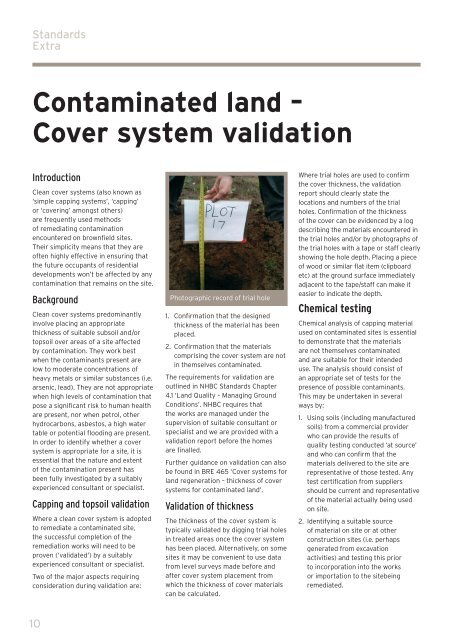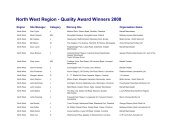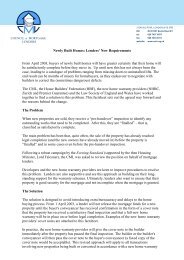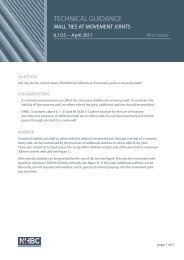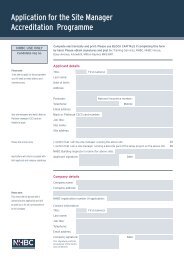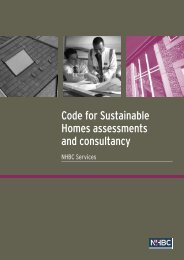June 2010 - NHBC Home
June 2010 - NHBC Home
June 2010 - NHBC Home
You also want an ePaper? Increase the reach of your titles
YUMPU automatically turns print PDFs into web optimized ePapers that Google loves.
Standards<br />
Extra<br />
Contaminated land –<br />
Cover system validation<br />
Introduction<br />
Clean cover systems (also known as<br />
‘simple capping systems’, ‘capping’<br />
or ‘covering’ amongst others)<br />
are frequently used methods<br />
of remediating contamination<br />
encountered on brownfield sites.<br />
Their simplicity means that they are<br />
often highly effective in ensuring that<br />
the future occupants of residential<br />
developments won’t be affected by any<br />
contamination that remains on the site.<br />
Background<br />
Clean cover systems predominantly<br />
involve placing an appropriate<br />
thickness of suitable subsoil and/or<br />
topsoil over areas of a site affected<br />
by contamination. They work best<br />
when the contaminants present are<br />
low to moderate concentrations of<br />
heavy metals or similar substances (i.e.<br />
arsenic, lead). They are not appropriate<br />
when high levels of contamination that<br />
pose a significant risk to human health<br />
are present, nor when petrol, other<br />
hydrocarbons, asbestos, a high water<br />
table or potential flooding are present.<br />
In order to identify whether a cover<br />
system is appropriate for a site, it is<br />
essential that the nature and extent<br />
of the contamination present has<br />
been fully investigated by a suitably<br />
experienced consultant or specialist.<br />
Capping and topsoil validation<br />
Where a clean cover system is adopted<br />
to remediate a contaminated site,<br />
the successful completion of the<br />
remediation works will need to be<br />
proven (‘validated’) by a suitably<br />
experienced consultant or specialist.<br />
Two of the major aspects requiring<br />
consideration during validation are:<br />
Photographic record of trial hole<br />
1. Confirmation that the designed<br />
thickness of the material has been<br />
placed.<br />
2. Confirmation that the materials<br />
comprising the cover system are not<br />
in themselves contaminated.<br />
The requirements for validation are<br />
outlined in <strong>NHBC</strong> Standards Chapter<br />
4.1 ‘Land Quality – Managing Ground<br />
Conditions’. <strong>NHBC</strong> requires that<br />
the works are managed under the<br />
supervision of suitable consultant or<br />
specialist and we are provided with a<br />
validation report before the homes<br />
are finalled.<br />
Further guidance on validation can also<br />
be found in BRE 465 ‘Cover systems for<br />
land regeneration – thickness of cover<br />
systems for contaminated land’.<br />
Validation of thickness<br />
The thickness of the cover system is<br />
typically validated by digging trial holes<br />
in treated areas once the cover system<br />
has been placed. Alternatively, on some<br />
sites it may be convenient to use data<br />
from level surveys made before and<br />
after cover system placement from<br />
which the thickness of cover materials<br />
can be calculated.<br />
Where trial holes are used to confirm<br />
the cover thickness, the validation<br />
report should clearly state the<br />
locations and numbers of the trial<br />
holes. Confirmation of the thickness<br />
of the cover can be evidenced by a log<br />
describing the materials encountered in<br />
the trial holes and/or by photographs of<br />
the trial holes with a tape or staff clearly<br />
showing the hole depth. Placing a piece<br />
of wood or similar flat item (clipboard<br />
etc) at the ground surface immediately<br />
adjacent to the tape/staff can make it<br />
easier to indicate the depth.<br />
Chemical testing<br />
Chemical analysis of capping material<br />
used on contaminated sites is essential<br />
to demonstrate that the materials<br />
are not themselves contaminated<br />
and are suitable for their intended<br />
use. The analysis should consist of<br />
an appropriate set of tests for the<br />
presence of possible contaminants.<br />
This may be undertaken in several<br />
ways by:<br />
1. Using soils (including manufactured<br />
soils) from a commercial provider<br />
who can provide the results of<br />
quality testing conducted ‘at source’<br />
and who can confirm that the<br />
materials delivered to the site are<br />
representative of those tested. Any<br />
test certification from suppliers<br />
should be current and representative<br />
of the material actually being used<br />
on site.<br />
2. Identifying a suitable source<br />
of material on site or at other<br />
construction sites (i.e. perhaps<br />
generated from excavation<br />
activities) and testing this prior<br />
to incorporation into the works<br />
or importation to the sitebeing<br />
remediated.<br />
10


